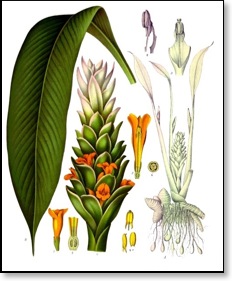Turmeric (Curcuma longa) is
a perennial plant of the ginger family. It is native to tropical
South Asia and needs temperatures between 68°F and 86°F, and a
considerable amount of annual rainfall to thrive. Plants are
gathered annually for their rhizomes, and re-seeded from some of
those rhizomes in the following season.
The rhizomes are boiled for several hours and then dried in hot
ovens, after which they are ground into a deep orange-yellow powder
commonly used as a spice in curries and other South Asian and
Middle Eastern cuisine. Its active ingredient is curcumin and it
has an earthy, bitter, peppery flavor and a mustardy smell.
In medieval Europe, turmeric became known as Indian Saffron, since
it is widely used as an alternative to the far more expensive
saffron spice.
Sangli, a town in the southern part of the Indian state of
Maharashtra, is the largest and most important trading center for
turmeric in Asia, maybe the entire world.
Turmeric
Turmeric


All rights reserved. Copyright © 2009 Chié Sonia - 1001 Bridgeway, #161 - Sausalito, CA 94965